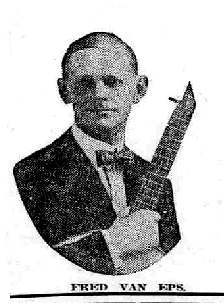Table of Contents
The Banjo Virtuoso You’ve Probably Never Heard Of
In the late 19th and early 20th centuries, when the banjo was transitioning from its folk roots to a more popular instrument, one man emerged who elevated its status and redefined its potential: Fred Van Eps. A virtuoso in the truest sense, Van Eps possessed an unparalleled mastery of the five-string banjo. His innovative techniques and intricate compositions transformed the way the instrument was perceived, paving the way for future generations of banjo players.

While his name might not be as widely recognized as some of his contemporaries, his impact on the world of music is undeniable. This week, we delve into the life and legacy of this remarkable musician, exploring his journey from playing classical guitar to becoming a pioneer of the five-string banjo.
From Plainfield to the Concert Stage
Born on October 13, 1878, in Plainfield, New Jersey, Fred Van Eps was immersed in music from the very beginning. His father, William Van Eps, was a prominent figure in the musical community, a true multi-instrumentalist proficient in violin, guitar, and cornet. The elder Van Eps even led his own orchestra, ensuring that music was a constant presence in young Fred’s life. It was within this vibrant and melodic environment that Fred’s own musical talents began to blossom.
Initially, Fred gravitated towards the classical guitar, an instrument that allowed him to explore the intricate melodies and harmonies of the European masters. He diligently studied the works of renowned composers, mastering the technical demands and expressive nuances of the instrument. His dedication and talent were evident, and for a time, it seemed that Fred was destined to follow in his father’s footsteps as a respected guitarist.
However, fate, it seemed, had other plans. The banjo, an instrument often associated with minstrel shows and folk music, began to capture Fred’s attention. Its bright, almost percussive sound, offered a stark contrast to the refined tones of the classical guitar. The banjo’s growing popularity in the late 19th century, fueled by the rise of ragtime and the banjo orchestras that were springing up across the country, further piqued Fred’s interest.
This fascination with the banjo marked a turning point in Fred’s musical journey. He was drawn to the instrument’s versatility, its ability to convey both joy and melancholy, and its potential for improvisation. The banjo represented a departure from the rigid structures of classical music, offering a freedom of expression that resonated with Fred’s artistic spirit. This transition from the classical guitar to the banjo would prove to be a defining moment in his career, setting the stage for him to become a true innovator and pioneer in the world of banjo music.
Redefining the Banjo: The Van Eps Technique
Fred Van Eps didn’t just play the banjo; he revolutionized it. His approach to the instrument was nothing short of groundbreaking. He drew inspiration from his classical guitar background, adapting techniques and fingerings to the five-string banjo. This innovative approach, which became known as the “Van Eps style,” involved using the thumb and three fingers of his right hand to pluck the strings, much like a classical guitarist. This method allowed for greater precision and speed, enabling him to execute complex melodies and harmonies that were previously considered impossible on the banjo.
Yet his influence extended beyond mere technique. He was a prolific composer, creating intricate pieces that showcased the banjo’s versatility and expressive range. His compositions were far removed from the simple folk tunes and minstrel songs typically associated with the instrument. Instead, they were sophisticated works that incorporated elements of classical and ragtime music, demonstrating the banjo’s potential as a serious concert instrument.
Through his innovative playing style and challenging compositions, Van Eps shattered the prevailing stereotypes surrounding the banjo. He elevated it from its humble origins to a position of respect within the musical community. His influence was profound, inspiring countless banjo players to explore new possibilities and push the boundaries of the instrument. Van Eps’s legacy is not just that of a skilled musician, but of a visionary who transformed the way the banjo was perceived and played.
A Legacy Etched in Wax: Van Eps’s Recordings
Though his name may be unfamiliar to many today, Fred Van Eps’s music has thankfully been preserved for posterity. He made numerous recordings throughout his career, capturing his unique style and virtuosity for future generations to appreciate. These recordings offer a glimpse into the golden age of banjo playing, showcasing the intricate melodies and innovative techniques that defined Van Eps’s sound.
Some of his most notable recordings include “Yankee Doodle,” “The Stars and Stripes Forever,” and “St. Louis Tickle.” These pieces demonstrate his remarkable ability to adapt well-known tunes to the banjo, adding his own distinctive flair and technical brilliance. Listening to these recordings today, one can’t help but be impressed by the sheer skill and musicality of this pioneering banjoist.
Fred Van Eps’s contribution to the development of banjo music cannot be overstated. He was a true innovator, pushing the boundaries of the instrument and expanding its expressive potential. His influence can be heard in the playing of countless banjoists who followed in his footsteps, from the early pioneers of bluegrass to contemporary virtuosos. Van Eps’s legacy serves as a reminder that even the most familiar instruments can be reimagined and redefined, leading to new and exciting musical possibilities.
Selected Songs
The Original Fox Trot
Old Folks Rag
The Burglar Buck
Cupid’s Arrow
